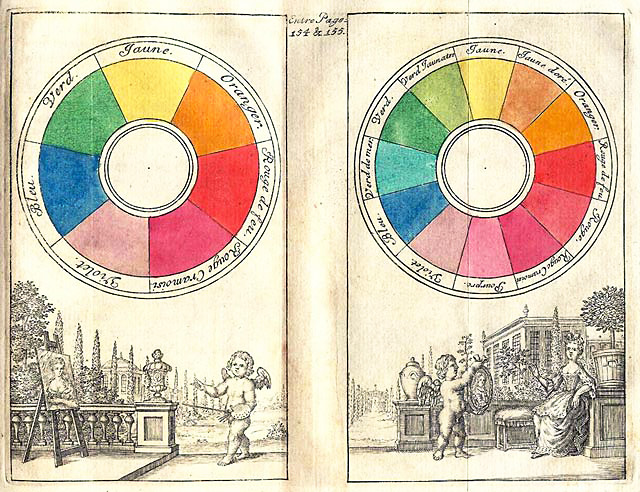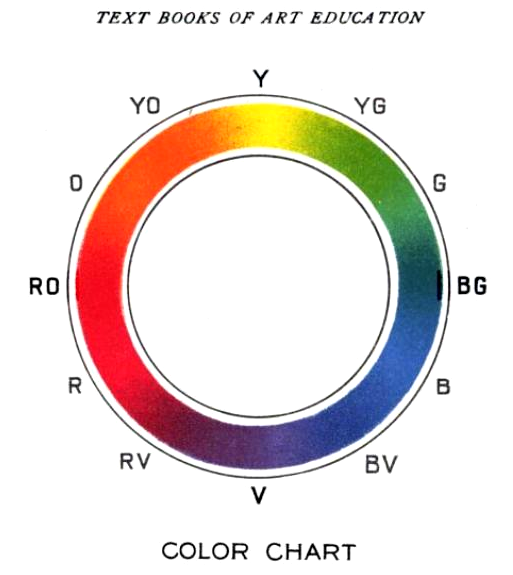1977.Something I didn't know until recently was that the concept of the Color Wheel itself–the flash of genius that caused someone to realize that you could arrange the producible colors in a logical wheel that not only displayed the natural progression but also turned the idea of color combining into an accessable thinking thing–blazed in the mind of none other than Sir Isaac Newton.

Not to belabor the point overmuch, but this is your general basic additive RYB color wheel. It's more than a logical progression for colors but a guide on how to produce more. To cover the obvious just for the sake of completeness, you start with your primaries–Red, Yellow, and Blue. These are the primaries, the colors from which all others flow and which cannot be further reduced. Exactly halfway between these colors are Green (Yellow+Blue), Orange (Yellow+Red) and Violet (Red+Blue), made with ideal equal proportions of the ideal primaries. Rounding out (if you'll excuse) the primaries and the adjacent secondaries produce the tertiaries.
In practice, of course, there's no such thing as an ideal, perfect primary. every color you get from a tube, crayon, or pencil has a very subtle bias, which is an idea I've lived with for a while and will write on very shortly.
The reason I wrote all the obviousness above is because the idea of the color wheel is a natural poetry that appeals. It's such a simple thing and works so very brilliantly, it's the most simple and effective guide to how to get what you want out of what you got ... it's born in logic and then transcends logic.
And I can't believe how highfalutin' I've gotten all of a sudden over the simple color wheel but I do whenever I realize what a quantum leap it was. I'd like to have been in the lab when Newton hit upon this. Well, that and when he figured out how to make them cookies (mmm, Fig Newtons(™ probabaly))!).
The reason I visited the color wheel is that I wanted to look through history. Wikipedia, while not 100% trustworthy, seems to have good examples.
This, for one, is Newtons original color wheel, diagrammed, correlated with musical notes and astrological symbols for planets (see, I said it was all kind of subjective):

Note, interstingly, that Newton came up with only seven colors. The color wheel's evolved since it was devised. As a matter of fact, let me direct your attention to Boutet's wheels, which came in seven and twelve color flavors:

Ahh, cherubs and unnecessary illustration. This dates from the 18th C, 1708 to be exact, so this was probably sehr teuer, if you catch my German drift. Not too many could have afforded the book that contained it.
Speaking of the German, even the great Goethe got into the act:

This from his 1810 work, Theory of Colours.
This color circle, from a 1904 book, wouldn't look to out-of-place in an art manual in modern times:

It also ID's the colors by initialisms around the rim. Very useful.
Actuallly preparing a color wheel should be something I will do very soon now, since it's simply fun playing with paint, and something I will post here as soon as I can get it up.
There are a couple of other nifty wheel designs to be seen at the Wikipedia entry here.
Technorati Tags: color theory, color wheel, color circle, color, color design

Not to belabor the point overmuch, but this is your general basic additive RYB color wheel. It's more than a logical progression for colors but a guide on how to produce more. To cover the obvious just for the sake of completeness, you start with your primaries–Red, Yellow, and Blue. These are the primaries, the colors from which all others flow and which cannot be further reduced. Exactly halfway between these colors are Green (Yellow+Blue), Orange (Yellow+Red) and Violet (Red+Blue), made with ideal equal proportions of the ideal primaries. Rounding out (if you'll excuse) the primaries and the adjacent secondaries produce the tertiaries.
In practice, of course, there's no such thing as an ideal, perfect primary. every color you get from a tube, crayon, or pencil has a very subtle bias, which is an idea I've lived with for a while and will write on very shortly.
The reason I wrote all the obviousness above is because the idea of the color wheel is a natural poetry that appeals. It's such a simple thing and works so very brilliantly, it's the most simple and effective guide to how to get what you want out of what you got ... it's born in logic and then transcends logic.
And I can't believe how highfalutin' I've gotten all of a sudden over the simple color wheel but I do whenever I realize what a quantum leap it was. I'd like to have been in the lab when Newton hit upon this. Well, that and when he figured out how to make them cookies (mmm, Fig Newtons(™ probabaly))!).
The reason I visited the color wheel is that I wanted to look through history. Wikipedia, while not 100% trustworthy, seems to have good examples.
This, for one, is Newtons original color wheel, diagrammed, correlated with musical notes and astrological symbols for planets (see, I said it was all kind of subjective):

Note, interstingly, that Newton came up with only seven colors. The color wheel's evolved since it was devised. As a matter of fact, let me direct your attention to Boutet's wheels, which came in seven and twelve color flavors:

Ahh, cherubs and unnecessary illustration. This dates from the 18th C, 1708 to be exact, so this was probably sehr teuer, if you catch my German drift. Not too many could have afforded the book that contained it.
Speaking of the German, even the great Goethe got into the act:

This from his 1810 work, Theory of Colours.
This color circle, from a 1904 book, wouldn't look to out-of-place in an art manual in modern times:

It also ID's the colors by initialisms around the rim. Very useful.
Actuallly preparing a color wheel should be something I will do very soon now, since it's simply fun playing with paint, and something I will post here as soon as I can get it up.
There are a couple of other nifty wheel designs to be seen at the Wikipedia entry here.
Technorati Tags: color theory, color wheel, color circle, color, color design

No comments:
Post a Comment